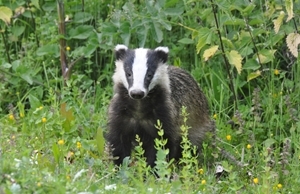Badger (Meles meles)
 Badgers seem to be constantly discussed in our media in connection with TB, but I thought it might be interesting to write a little about the creature itself, to look at the ecology of an animal that has inhabited Britain for at least 250,000 years.
Badgers seem to be constantly discussed in our media in connection with TB, but I thought it might be interesting to write a little about the creature itself, to look at the ecology of an animal that has inhabited Britain for at least 250,000 years.
We all know what badgers look like as most of us were brought up on Kenneth Grahame’s The Wind in the Willows (1908), with the rather bad tempered, but nevertheless respected Badger, who was somewhat elusive and lived deep in the wild wood. Many people have never actually seen a live badger, only dead ones beside the road, but they still evoke a huge amount of affection in the public’s mind, probably because of this story book.
The European badger (Meles meles) belongs to the family of mammals known as the Mustelidae (possessing musk glands), otherwise known as the weasel family and includes the otter, stoat, polecat, ferret and pine marten. The name badger is believed to come from the French becheur meaning digger. Male badgers are called boars, females are sows and the young are cubs. Unlike dogs or foxes, badgers have five toes and very powerful, long claws, particularly on the front feet, which equip them well for their lifestyle of digging.
Badgers live in social groups of around half a dozen or so adults – though colonies of up to 23 adults have been recorded – and they spend about 70% of their time in a system of underground tunnels and chambers which is known as a sett. There is normally a main “HQ” in the middle of the territory, which on average covers an area of about a square mile, but with a series of outlying smaller setts also dotted around the rest of the territory. These secondary setts tend to be used only during the summer months for lying-up in during the day. They also provide good bolt holes should danger occur while a long way from the main sett.
Many main setts are centuries old and a Mammal Society survey found that badger sett density increases with hilliness, showing that 92% of setts were dug into the side of a slope to help with soil removal and drainage. The biggest sett ever discovered had a staggering 200 holes – the equivalent of a badger capital city no doubt!
Cubs are born during February in specific nesting chambers within the core sett (only occasionally, if a second sow becomes pregnant, will she use an outlying sett), which like the resting chambers is lined with grass or bracken and cleaned out on a regular basis to help reduce mites and fleas. Although mating takes place during the spring months, the implantation is delayed until late winter. Only one female badger in a social group normally breeds, producing a litter of 2 or 3 blind and hairless cubs. They usually appear above ground at about 8 weeks, are weaned by about 12 weeks, and are feeding independently by late summer.
Badgers have been shown to exhibit alloparental behaviour; in other words individuals co-operate with the mother in rearing her young. This enables the mother to spend more time finding food during the time she is suckling and may well give essential experience to younger sows, who gain the skills to help them raise cubs of their own one day.
Badgers are truly omnivorous and I often say that their motto should be “if you can swallow it, then you can eat it”! Earthworms form the major part of their diet as long as they can get at them – droughts or very hard frosts can change this – but a wide range of other foods are taken such as insects (including honey bee, bumble bee and wasp nests – they like the grubs and honey!), nuts, berries, roots, bulbs, carrion, eggs and mammals including the hedgehog. In fact many believe that part of the huge reduction in bumble bee and hedgehog numbers in the wider countryside is due to the badgers’ increasing population size. In 1988 there were estimated to be around 200,000 badgers in the UK but, following full protection in 1992, some estimates now put the total UK badger population at around 350,000.
Finally, badgers mark out their territories by creating latrines along the boundary and it is quite easy therefore to find out how big your local badger sett’s territory is, simply by feeding a mix of peanuts, syrup and indigestible coloured pellets! A different coloured pellet is allocated to each individual sett, so that on finding a badger’s dung pit, you can quickly identify which sett it belongs to! This can of course be important when designing the course of a new road or applying for planning permission for a new housing estate. Many a plan has been stalled by a coloured pellet or two!
Peter Thompson
Advisory
Read more from Peter Thompson at the Fresh from the Field blog.

Download Peter Thompson's essential 26-page book, featuring beautiful photography and detailed profiles of Britain's wildlife
Download FREE >